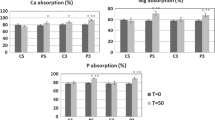Abstract
Oxalate reduces calcium availability of food because it chelates calcium, forming the sparingly soluble salt calcium-oxalate. Nevertheless, fat sand rats (Psammomys obesus; Gerbillinae) feed exclusively on plants containing much oxalate. We measured the effects of calcium intake on oxalate balance by comparing oxalate intake and excretion in wild fat sand rats feeding on their natural, oxalate-rich, calcium-poor diet with commercially-bred fat sand rats feeding on an artificial, calcium-rich, oxalate-poor diet of rodent pellets. We also tested for the presence of the oxalate degrading bacterium Oxalobacter sp. in the faeces of both groups. Fat sand rats feeding on saltbush ingested significantly more oxalate than fat sand rats feeding on pellets (P < 0.001) and excreted significantly more oxalate in urine and faeces (P < 0.01 for both). However the fraction of oxalate recovered in excreta [(oxalate excreted in urine + oxalate excreted in faeces)/oxalate ingested] was significantly higher in pellet-fed fat sand rats (61%) than saltbush-fed fat sand rats (27%). We found O. sp. in the faeces of both groups indicating that fat sand rats harbor oxalate degrading bacteria, and these are able, to some extent, to degrade oxalate in its insoluble form.



Similar content being viewed by others
References
Allison MJ, Dawson KA, Mayberry WR, Foss JG (1985) Oxalobacter formigenes Gen-Nov, Sp-Nov—Oxalate-degrading anaerobes that inhabit the gastrointestinal-tract. Arch Microbiol 141:1–7
Belliveau J, Griffin H (2001) The solubility of calcium oxalate in tissue culture media. Anal Biochem 291:69–73
Beuchat CA (1996) Structure and concentrating ability of the mammalian kidney: Correlations with habitat. Am J Physiol-Regulat Integr Compar Physiol 40:R157–R179
Daly M, Daly S (1973) On the feeding ecology of Psammomys obesus (Rodentia, Gerbillidae) in the Wadi Saoura, Algeria. Mammalia 37:545–561
Daniel SL, Hartman PA, Allison MJ (1987) Intestinal Colonization of Laboratory Rats with Oxalobacter formigenes. Appl Environ Microbiol 53:2767–2770
De Lorenzi D, Bernardini M, Pumarola M (2005) Primary hyperoxaluria (l-glyceric aciduria) in a cat. Journal of Feline Medicine and Surgery 7:357–361
Degen AA, Kam M, Jurgrau D (1988) Energy-Requirements of Fat Sand Rats (Psammomys-Obesus) and Their Efficiency of Utilization of the Saltbush Antriplex halimus for Maintenance. J Zool 215:443–452
Degen AA, Kam R, Khokhlova IS, Zeevi K (2000) Fiber digestion and energy utilization of fat sand rats (Psammomys obesus) consuming the chenopod Anabasis articulata. Physiol Biochem Zool 73:574–580
Ellern SJ, Samish YB, Lachover D (1974) Salt and oxalic acid content of leaves of the saltbush Atriplex halimus in the northern Negev. J Range Manage 27:267–271
Franceschi VR, Loewus FA (1995) Oxalate biosynthesis and function in plants and fungi. In: Khan SR (ed) Calcium oxalate in biological systems. CRC Press, Boca Raton, pp 113–130
Justice KE (1985) Oxalate Digestibility In Neotoma albigula And Neotoma mexicana. Oecologia 67:231–234
Kam M, Degen AA (1988) Water, Electrolyte and Nitrogen Balances of Fat Sand Rats (Psammomys obesus) When Consuming the Saltbush Atriplex halimus. J Zool 215:453–462
Knoll T, Steidler A, Trojan L, Sagi S, Schaaf A, Yard B, Michel MS, Alken P (2004) The influence of oxalate on renal epithelial and interstitial cells. Urol Res 32:304–309
Kolthoff I, Sandell E, Meehan E, Bruckenstein S (1969) Quantitative chemical analysis. Collier-Macmillan, London
Korine C, Vatnick I, van Tets IG, Pinshow B (2003) New observations on urine contents in water-deprived Negev Desert rodents. Can J Zool Rev Can Zool 81:941–945
Marangella M, Vitale C, Petrarulo M (1996) Primary and enteric hyperoxaluria: Two non-renal causes of nephrolithiasis. Intal J Miner Electrolyte Metab 10:123–129
Mendelssohn H, Yom-Tov Y (1999) Fauna Paleaestina: Mammalia of Israel. The Israel Academy of Sciences and Humanities, Jerusalem
Mittal RD, Kumar R, Bid HK, Mittal B (2005) Effects of antibiotics on Oxalobacter formigenes colonization of human gastrointestinal tract. J Endourology 19:102–106
Noonan SC, Savage GP (1999) Oxalate content of food and its effect on humans. Asia Pac J Clin Nutr 8:64–74
O’Brien RG (1979) A general ANOVA method for robust tests of additive models for variances. J Am Stat Assoc 74:877–880
Ouali S, Bensalem M (1996) Anatomical and structural studies of two desert rodent kidneys: Gerbillus gerbillus and Psammomys obesus. Bull Soc Zool FR Evol Zool 121:103–106
Palgi N, Vatnick I, Pinshow B (2005) Oxalate, calcium and ash intake and excretion balances in fat sand rats (Psammomys obesus) feeding on two different diets. Comp Biochem Physiol A Mol Integr Physiol 141:48–53
Petrarulo M, Vitale C, Facchini P, Marangella M (1998) Biochemical approach to diagnosis and differentiation of primary hyperoxalurias: an update. J Nephrol 11:23–28
Schmidt-Nielsen B, O’Dell R (1961) Structure and concentrating mechanism in the mammalian kidney. Am J Physiol 200:1119–1124
Shapiro SS, Wilk MB (1967) An analysis of variance test for normality (complete samples). Biometrika 52:591–611
Shirley EK, Schmidt-Nielsen K (1967) Oxalate metabolism in the pack rat, sand rat, hamster, and white rat. J Nutr 91:496–502
Sidhu H, Enatska L, Ogden S, Williams WN, Allison MJ, Peck AB (1997) Evaluating children in the Ukraine for colonization with the intestinal bacterium Oxalobacter formigenes, using a polymerase chain reaction-based detection system. Mol Diagn 2:89–97
Acknowledgments
We thank Regina Goldin-Tzirkin, Ilana Dolev and Ahuva Vonshak for technical assistance. We thank two anonymous referees whose comments helped to improve this paper. This research was partly supported by a Sigma Xi grant-in-aid-of-research and by a student support grant from the Mitrani Department of Desert Ecology (MDDE), both to NP. This is publication 598 of the MDDE.
Author information
Authors and Affiliations
Corresponding author
Additional information
Communicated by I.D. Hume.
Rights and permissions
About this article
Cite this article
Palgi, N., Ronen, Z. & Pinshow, B. Oxalate balance in fat sand rats feeding on high and low calcium diets. J Comp Physiol B 178, 617–622 (2008). https://doi.org/10.1007/s00360-008-0252-1
Received:
Revised:
Accepted:
Published:
Issue Date:
DOI: https://doi.org/10.1007/s00360-008-0252-1




